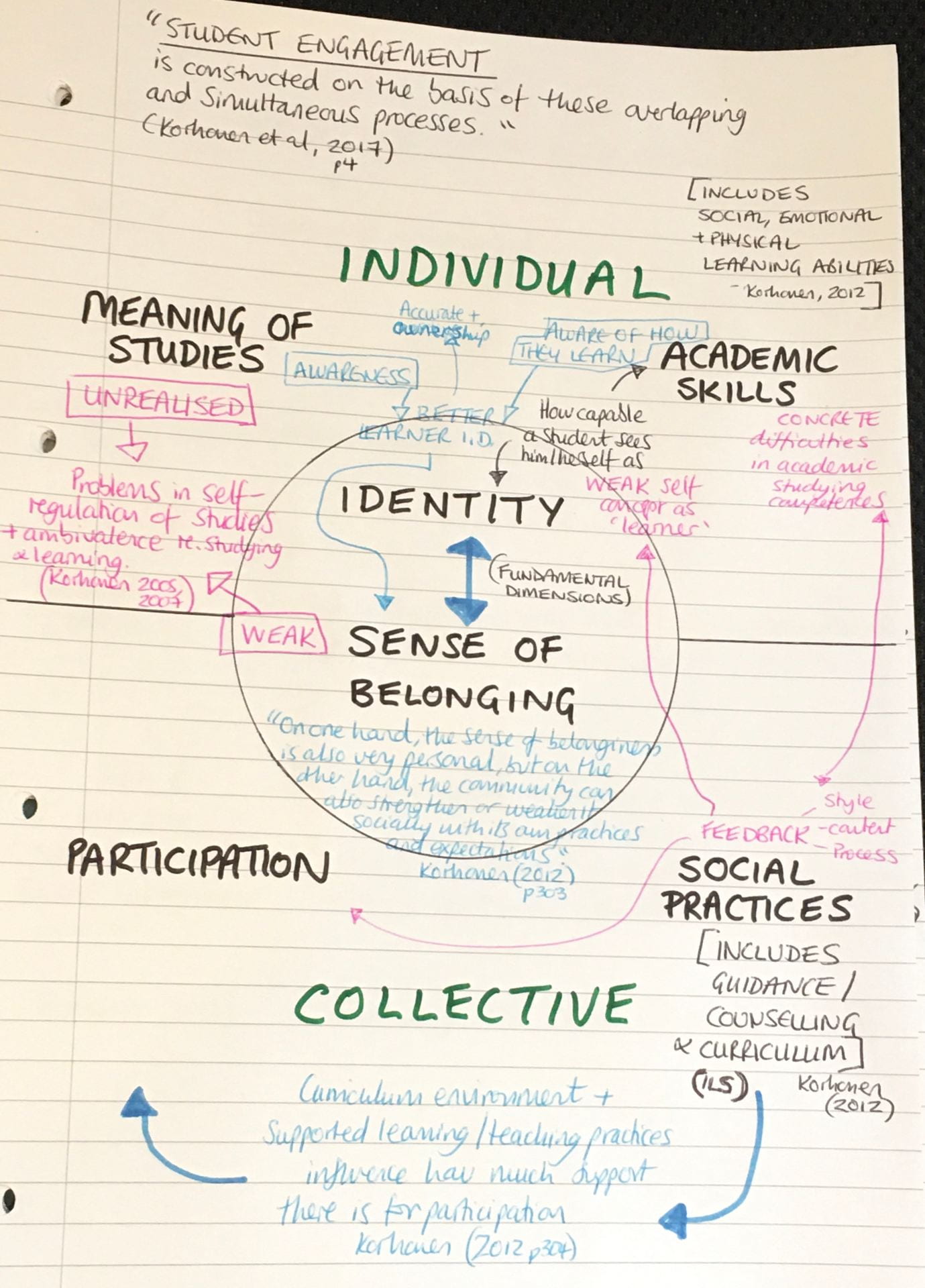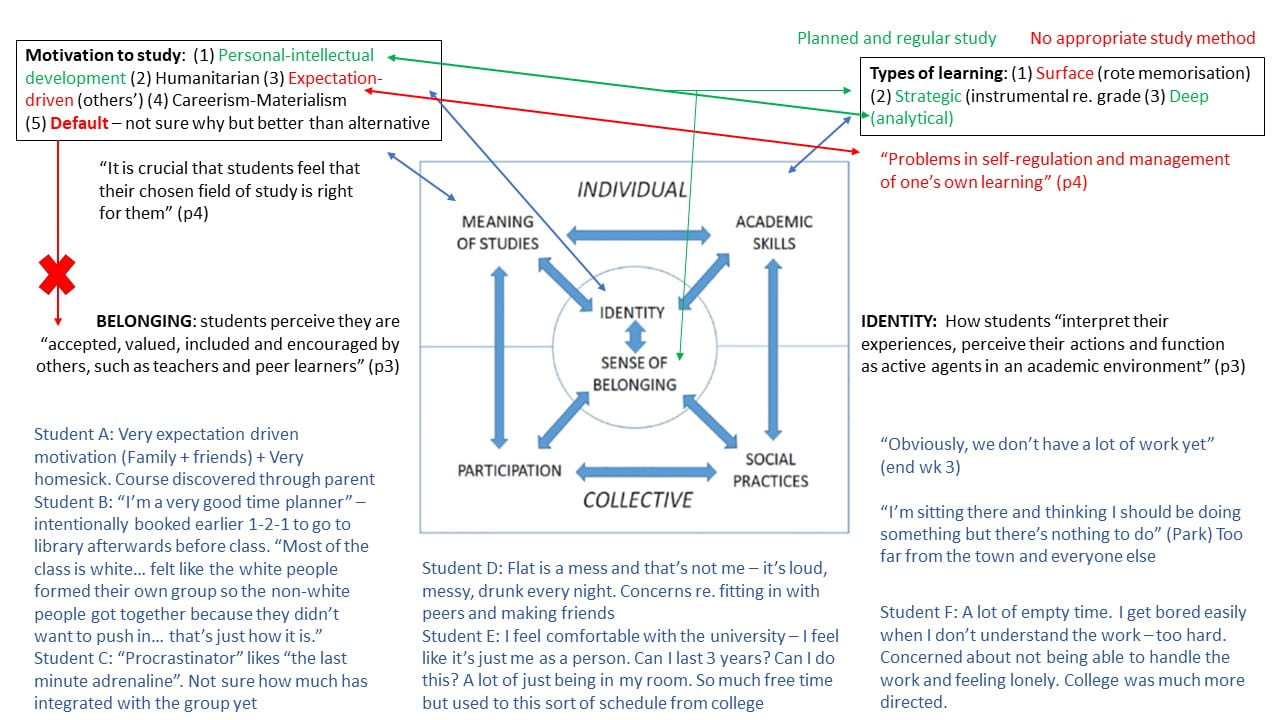One of the key (and most challenging) goals of this project was to ‘map’ a synthesis of data to establish whether (and how) more meaningful and individually responsive indicators might be identifiable to support student retention, continuation and progression.
Korhonen et al (2019) created a model of student engagement, that can be seen evolving from Korhonen (2012) and through Korhonen et al (2017). The model is presented in Korhonen et al (2019, p2) as below:
Their aim was to conceptualise a model that reflects the multidimensional, complex and dynamic processes of interaction, shaping student engagement. They locate ‘identity’ and ‘sense of belonging’ as the central dimensions, with four key contextual elements of: ‘meaning of studies’, ‘participation’, ‘social practices’ and ‘academic skills’. For each individual student, these elements will interact differently and different combinations will have differing impacts.
The image above illustrates how I have used Korhonen et al‘s (op cit) model to start to make sense of some of the interconnections running through this project’s data, and where the connections between particular elements might present useful indicators we could use to initiate and develop supportive intervention. (Red font suggests problematic connections. Blue font is about positives)
So, we need to be clear about what comprises each of these elements. The ‘social practices’ element (and its influence on ‘participation’) I have summarised in the image above. Korhonen’s 2012 article specifically focuses on this element of the model, with a central focus on the ‘wholeness’ of the student experience that would relate to our integrated learner services approach at UoN. This article shows how ‘social practices’ might interact with ‘academic skills’ and ‘meaning of studies’, “supporting students in their goal-oriented studying, in their development of expertise, and in their personal development and growth” (Korhonen, 2012, p298). Which would in turn inform a student’s identity and belonging, such that ‘social practices’ are essentially emphasising student-centred “objectives for better engagement” (op cit).
During our Diamond 9 discussions, the importance of meaningful participation (rather than ‘presenteeism’) was brought up in several groups. In my Diamond 9 blog I drew the parallel between students’ views of meaningful engagement and the concept of ‘Presence, Participation and Achievement’ as presented in ‘The Index for Inclusion‘. In Korhonen et al‘s (2019) model of student engagement, the participation element must be meaningful. Superficiality of contacts or participation relate to studying as lonely and a grind, with negative impact for sense of belonging and identity, and (consequently) retention, continuation and progression. Students’ individual life situations (such as hours spent in paid employment, caring responsibilities, IT access) “can restrict the possibilities to participate in studying communities” (Korhonen, 2012, p304) such that concepts like ‘barriers to Inclusion’ are very relevant to the student engagement narrative.
The image below shows Korhonen et al‘s (2019) model again, and adds my summary of their detail about study motivation alongside ‘meaning of studies’, and detail about types of learning alongside ‘academic skills’ – since these are presented as inextricably interacting. Green font suggests a positive for student engagement and continuation, and red font suggests a concern.
To help consider the potential utility of this model, several anonymised comments from tutorials in weeks 2 and 3 are included in the image below for consideration:
Students comments:
Even in these initial 1-2-1 PAT conversations, it is clearly possible to map student comments to particular elements of the model. Conscious awareness of where these comments are located on the map/model might help us investigate and have conversations around potential connections with other emergent concerns or issues, in ways that could help target support, even at this very early stage. There is so much data potentially available, that in this way, such a model might help us navigate.
I am conscious that as I write this and look back now on these early tutorial comments, it is with the benefit of hindsight. However, it is that hindsight that persuades me to this model and allows me to consider what I might have done then had I mapped these initial comments in the context of this model and its connections.
Personal meaning of studies is “a pre-requisite” for student engagement (Korhonen et al, 2017, p5). Expectation-driven motivation for study (ie. driven by others’ expectations) has been associated with a lack of the practical organisational skills considered in previous blogs as a priority for development. Default motivation is particularly associated with risk of dropping out and negatively associated with a sense of belonging. “If the purpose of the studies remains unclear, this can quickly lead to drop-out or intentions to change the study field, which are the most common causes of a slow start and a non-committed orientation to studies” (op cit, p5-6). Both students who indicated a default motivation in their initial questionnaires had conversations with me (in that week 3-6 wobble week time frame) about potentially dropping out, with the student for whom that motivation was the most prevalent completing (but not submitting) withdrawal paperwork. However, it is critical to flag that default motivation was by far from the only factor involved in influencing potential withdrawal. Additionally, this student described (and describes) themselves as engaged in their studies and tutors agree that they are passionate and heartfelt in their engagement with the programme material.
So, how can we use such a model if the variations seem so infinite? We should avoid ‘engagement bingo’ at all costs, which is arguably the issue with using learner analytics such as LEARN. However, the issue is more with how we use the indicators than whether or not those indicators are significant. Korhonen (2012, p312) is clear that students need to be seen as “active constructors” of their own lives. I appreciate that a rationale for students having access to their data on LEARN may be to encourage that sense of ownership. However, attribution error or just misinterpretation is as possible for students in interpreting their own data as it is for PATs or organisations at an individual or collated level. In research, we know that good practice to address such risk is to check with our participants. We need similar participant checks within our use of student data and they need to be meaningful – more than logged interactions on LEARN. We need to talk to our students explicitly about these elements of Korhonen et al‘s (2019) model of engagement, to help them recognise and understand, take ownership of, and communicate to us, elements influencing their engagement. This action would fall within the element of ‘Social Practices’ as part of our responsibility in removing barriers to Inclusion and supporting a diversity of students to engage and achieve. The ‘reality check’ here is that I would love to do this as an inherent part of my PAT role … but whilst generating the data is achievable within the time allocated and standard role brief, meaningfully collating, analysing and acting on it for each individual takes much more time than is allocated to the role… but could make so much difference.
As my study cohort approach completion of level 4, I am very conscious of Korhonen et al‘s (2017) warning that “those in the weakly engaging group from the first year of study onwards seem to remain in the group quite permanently, and the probability of belonging to the group even increases in the second academic year” (p1). In their study, the elements of greatest disparity between the clusters of students that were most and least engaged were ‘participation’ and ‘belonging’. Even without this knowledge, we may agree that these elements of engagement may require the most support in our current context of restricted face to face, and socially distanced interaction; so that they are also the two elements of greatest disparity between those who are most and least engaged should concern us re. potential widening of that gap. Korhonen et al (op cit) found that the importance of INDIVIDUAL elements of engagement – especially study skills – INCREASES in the second year of study. This is a potential opportunity and an element on which we should focus. Of all the elements in Korhonen’s model, it is perhaps the one least impacted by the challenges of the current context and, as such, may be able to act as a sort of ‘stable base’ from which we can build upwards and outwards to support the other elements within this system.
Korhonen, V. (2012) ‘Towards Inclusive Higher Education? – Outlining a Student-centred Counselling Framework for Strengthening Student Engagement’ in S. Stolz & P. Gonon (eds.) (2012) Challenges and Reforms in Vocational Education – Aspects of Inclusion and Exclusion. Bern: Peter Lang, 297-320.
Korhonen, V., Inkinen, M., Mattsson, M. and Toom, A. (2017) ‘Student engagement and the transition from the first to second year in higher education’, in Higher Education Transitions: Theory and Research, eds E. Kyndt, et al. (London: Routledge), 113–134. Accessed 04/07/20 at https://helda.helsinki.fi//bitstream/handle/10138/310654/Korhonen_et_al_2017.pdf?sequence=1
Korhonen, V., Mattsson, M., Inkinen, M. and Toom, A. (2019) ‘Understanding the multidimensional nature of Student Engagement during the first year of Higher Education’, Frontiers in Psychology, 10: 1056 pp1-15





